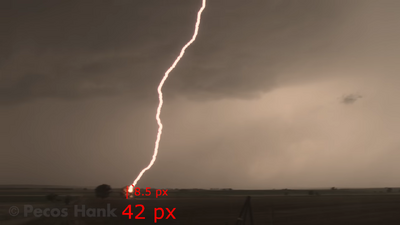- 1,738
- 842
View Voltage as the pressure in a garden hose, the smaller the space an amount of energy must pass, the greater the voltage.DMUA said:But how does it gain more voltage and energy as it goes down, then?
Follow along with the video below to see how to install our site as a web app on your home screen.
Note: This feature may not be available in some browsers.
View Voltage as the pressure in a garden hose, the smaller the space an amount of energy must pass, the greater the voltage.DMUA said:But how does it gain more voltage and energy as it goes down, then?
Actually, it ca. Especially in loose material such as dirt or sand, but even sometimes in stone.DMUA said:Luminosity can definitely inflate things, but I don't think an inch wide current can leave a meter wide crater on the ground
A bolt containing energy in the megatons would leave craters far larger than what you'd see in pretty much any of the feats calced. It's inconsistent with the damage it actually causes, if anything.DMUA said:If it's an outlier or otherwise inconsistent that's another ordeal, but if there's an indication the current is as wide as it appears, it should be completely fine.
To be entirely honest that doesn't even seem to look like lightning as much as it looks like a generic energy blast.DMUA said:What about something like this, where if you stand in the lightning bolt at all you get damaged? That seems like something that would be pretty indicative of current
Actually, yeah, this.DontTalkDT said:One could legitimately argue that there is no particular reason why the A/m^2 of ultra big lightning should be a specific constant.
That implies that there's a legitimate relationship between the cross-sectional area of a lighting bolt and its amperage, and it's defined by that specific equation.DontTalkDT said:The A/m^2 value is the result of taking the amperage of real lightning and dividing through the cross sectional area of real lightning.
Of course I'll point out that correlation does not equal causation; there's a theoretically infinite number of equations you could make up which could take the bolt's average radius + average timeframe and output our value for average energy but give out ridiculous results outside of that one data set.DMUA said:That said, I actually tested lightning math on IRL lightning to see if it was consistent (Something I should have probably considered before all this mess began)

This works until you consider that could just be multiple shades of light.Spinoirr said:Now if the writer shows the bolt and light are different by drawing an outline around the bolt to show the light or the light is stopped by someone who controls particules before it disappears then what?
You'd kind of expect greater inflation from brightness when the bolt is smack-dab in your face, and this is without going into how the math used here is actually related to lightning/electricity in general.Andytrenom said:Once again, are you really going to get this much inflation from a bolt observed up close, instead of miles away?
I like to assume the best of authors because it's very easy to take a "we know more than thou" attitude against writers when we're looking at their works with the benefit of hindsight. I feel like it's more that lightning being scientifically accurate isn't important to telling an interesting/engaging story, so they don't need to put effort in that department.Ricsi-viragosi said:I bet 99% of the authors/artists that make them don't even know that lightning is a few cm wide at best
Although if we're trying to visually identify part of the lightning and it's already ignoring how we'd visually identify it normally, that presents an issue, no? It'd be like calcing a bullet dodge when we can't identify where the bullet came from or when it was fired.Dargoo Faust said:This isn't me saying we can't judge superhuman feats at all, by the way
Except we aren't using real life physics to judge it to begin with. We're using a constant related to lightning (not even that, an average) fed through an equation in which we have no confirmation about its relation to lightning.Andytrenom said:just because lightning doesn't perfectly abide by realistic effects of luminosity doesn't mean using real life physics to judge it is a problem